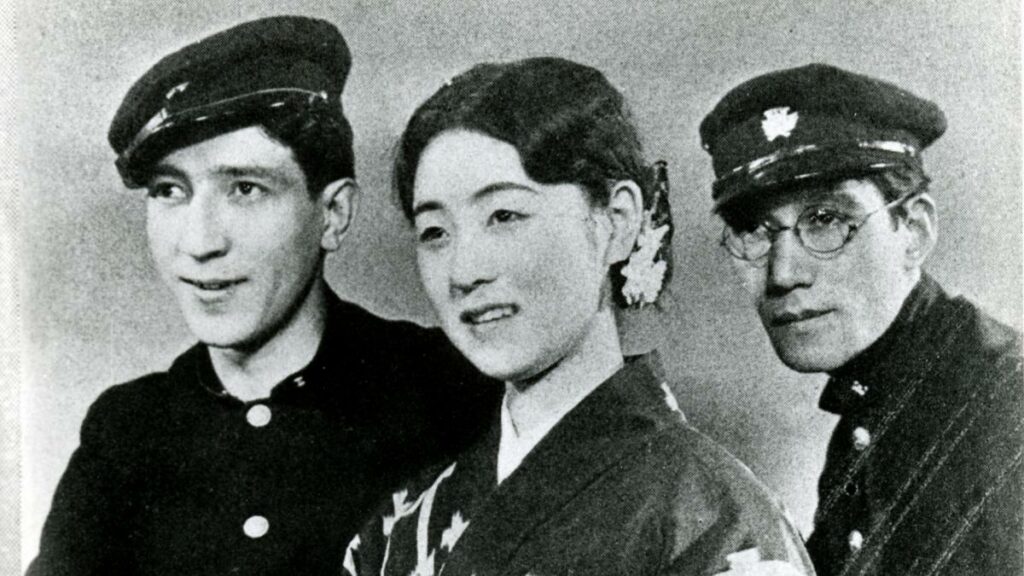On May 10, 1932, the Japanese media erupted with news regarding a recent tragedy at Mount Sakata in Kanagawa Prefecture. The bodies of Keio University student Goro Chosho and his girlfriend Yaeko Yuyama had been discovered on the slopes, the former clad in his school uniform, the latter wrapped in a kimono. As subsequent investigations determined, the couple had been forbidden to marry by Yuyama’s upperclass parents, and so they climbed the mountain, lay down next to one another facing the sea, and poisoned themselves.1 Capitalizing on the two having met at a Christian fellowship, Tokyo Nichinichi Shinbun ran a headline describing Chosho and Yuyama’s relationship as “A Love That Reached Heaven.”2 Resultant sensationalism and interest in their suicide spawned imitative effects throughout Japanese society—indicative of the public’s relation to the media at the time.
As historian Peter High notes in his book The Imperial Screen: Japanese Film Culture in the Fifteen Years’ War, 1931-1945: “Japanese social historians tend to sketch out the course of 1930s cultural history along a time line of consecutively occurring incidents and fads.”3 Granted, the impulse to emulate tragedy had been prevalent long before. In May 1903, eighteen-year-old philosophy major Misao Fujimura became a celebrity when he jumped from Kegon Falls after carving his farewell poem into a nearby tree. Over the next four years, more than a hundred and eighty people, inspired by news portraits of Fujimura as a martyr, attempted to kill themselves at the falls.4 Imitation of publicized suicides—especially those involving spiritual or erotic overtones—remained fervent in 1932, as demonstrated in what became known as “The Lovers’ Suicide Rage.” Within seven months of Chosho and Yuyama’s passing, over twenty couples traversed to Mount Sakata to end their lives.5
Concurrent with the copycat suicides was a surge in exploitative entertainment: radio dramas and stageplays about Chosho and Yuyama, romantic ballads released as bestselling records. Sure enough, the motion picture industry joined in on the craze. Yasujiro Ozu’s Where Now Are the Dreams of Youth? (1932) referenced the death toll through a jab of sardonic comedy: a young business executive, stuck escorting a woman his peers hope he’ll marry, suggests they go to Mount Sakata for a date. But perhaps most infamous was a feature-length dramatization of the original incident produced by Shochiku. Titled after the earlier mentioned Tokyo Nichinichi Shinbun headline, Heinosuke Gosho’s A Love That Reached Heaven premiered on June 10, 1932—exactly one month after the news stories first broke.6

While the picture’s now lost and information remains scant (Arthur Nolletti, Jr.’s sizable book on Gosho merely acknowledges it via two brief sentences), A Love That Reached Heaven became one of that year’s biggest releases, recuperating its five thousand-yen budget7 and then some. (Its popularity might’ve also stemmed from casting, as leads Ryoichi Takeuchi and Hiroko Kawasaki had been in the public eye before. Takeuchi became a tabloid favorite in 1927 for walking off a set with actress Yoshiko Okada.8 And in 1931’s Women Are in Every World, Kawasaki performed with Ichiro Yuki what’s believed to have been the first kiss in a Japanese motion picture; filmed when Japanese censorship strictly forbade love scenes, the kiss slipped into distribution only because Yuki distracted the censor in the screening room, the film subsequently withdrawn after a police officer spotted the scene during a theater patrol.)9
Widespread interest in Shochiku’s film spawned additional copycat suicides. Theater owners learned of moviegoers smuggling poison into the auditorium, and thus dispatched usherettes to monitor screenings for attendees attempting to take their lives during the drama. Sadly, “The Lovers’ Suicide Rage” worsened from here. In January 1933, two schoolgirls leaped into the stratovolcano Mount Mihara on Izu-Oshima Island, the news triggering a second wave of suicides that lasted until March—by which time approximately 944 people had perished in the caldera. The media remained quick to sensationalize. Responding to macabre public speculation, Yomiuri Shinbun newspaper lowered a gondola into the volcano to determine whether the victims had crashed onto the rocks or plunged straight into the magma.10
Meantime, Izu-Oshima’s local commerce boomed: stables increased their stock of horses, local schools started pilgrimage trips to Mount Mihara, and Tokyo steamship companies met the travel demand of anxious tourists by scheduling additional commutes to the island.11 By the time the rage finally subsided in spring 1933, one thing had been proven: the media and society together remained ravenous in their capitalizing on calamity. As Peter High writes in his book, what started as the personal tragedy of two people “was dramatically reworked, first by the press […] into a mass hysteria phenomenon of almost majestic proportions.”12
Works cited and further reading:
- Di Marco, Francesca. “Act or Disease? The Making of Modern Suicide in Early Twentieth-century Japan.” The Journal of Japanese Studies, vol. 29, no. 2 (Summer 2013), p. 347
- High, Peter B. The Imperial Screen: Japanese Film Culture in the Fifteen Years’ War, 1931-1945. Madison: University of Wisconsin Press, 2003, p. 28 (Disclaimer: I should note that High’s book claims the couple died by jumping into the mountain’s volcanic crater; but, when cross-referenced with other sources, this doesn’t appear to be the case.)
- Ibid, p. 27
- Di Marco, p. 336
- Ibid, p. 348
- Di Marco, p. 348
- Haukamp, Iris. A Foreigner’s Cinematic Dream of Japan: Representational Politics and Shadows of War in the Japanese-German Coproduction New Earth (1937). London: Bloomsbury Publishing, 2020 (Ebook)
- Wada-Marciano, Mitsuyo. Nippon Modern: Japanese Cinema of the 1920s and 1930s. Honolulu: University of Hawaii Press, 2008, pp. 95-6
- Hirano Kyoko. Smith Goes to Tokyo: Japanese Cinema Under the American Occupation, 1945-1952. Washington, D.C.: Smithsonian Institution Press, 1992, p. 154
- High, pp. 28-9
- Yoda Hiroko. “Spooky Izu: Tales of sorcerers and suicide on Izu Oshima.” CNN. 29 October 2009
- High, p. 27

